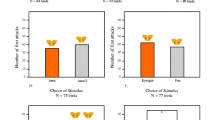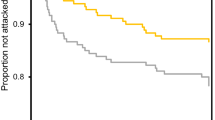Abstract
Animals utilise various strategies to reduce the risk of predation, including camouflage, warning colours and mimicry, and many of these protective signals promote avoidance behaviour in predators. For example, various species possess paired circular ‘eyespots’, which startle or intimidate predators, preventing or halting an attack. However, little is known of how the efficacy of such signals relates to the context in which they are found, and no studies have tested the relative effectiveness of anti-predator signals when on otherwise camouflaged and conspicuous prey. We find that the protective value of conspicuous wing spots, placed on artificial moth-like targets presented to wild birds in the field, is strongly affected by the attributes of the prey ‘animal’ on which they are found. Wing spots reduced predation when on conspicuous prey but were rendered ineffective when on otherwise camouflaged targets, indeed they increased the risk of predation compared to non-marked camouflaged controls. These results demonstrate how different anti-predator strategies may interact, and that protective signals can switch from being beneficial to costly under different contexts.



Similar content being viewed by others
References
Abràmoff MD, Magalhäes PJ, Ram SJ (2004) Image processing with image. J Biophot Int 7:36–43
Blest AD (1957) The function of eyespot patterns in the Lepidoptera. Behaviour 11:209–256
Brakefield PM, Larsen TB (1984) The evolutionary significance of dry and wet season forms in some tropical butterflies. Biol J Linn Soc 22:1–12
Cox DR (1972) Regression models and life-tables. J R Stat Soc B 34:187–220
Cott HB (1940) Adaptive coloration in animals. Methuen, London
Cuthill IC (2006) Color perception. In: Hill GE, McGraw KJ (eds) Bird coloration, vol. I: mechanisms & measurements. Harvard University Press, Cambridge, pp 3–40
Cuthill IC, Partridge JC, Bennett ATD, Church SC, Hart NS, Hunt S (2000) Ultraviolet vision in birds. Adv Stud Behav 29:159–214
Cuthill IC, Stevens M, Sheppard J, Maddocks T, Párraga CA, Troscianko TS (2005) Disruptive coloration and background pattern matching. Nature 434:72–74
Cuthill IC, Hiby E, Lloyd E (2006a) The predation costs of symmetrical cryptic coloration. Proc R Soc B 273:1267–1271
Cuthill IC, Stevens M, Windsor AMM, Walker HJ (2006b) The effects of pattern symmetry on the anti-predator effectiveness of disruptive and background matching coloration. Behav Ecol 17:828–832
Edmunds M (1974) Defence in animals: a survey of antipredator defences. Longman, Harlow
Endler JA (1993) The color of light in forests and its implications. Ecol Monog 63:1–27
Endler JA, Mielke PWJ (2005) Comparing color patterns as birds see them. Biol J Linn Soc 86:405–431
Gamberale-Stille G (2001) Benefit by contrast: an experiment with live aposematic prey. Behav Ecol 12:768–772
Hart NS (2001) The visual ecology of avian photoreceptors. Prog Retin Eye Res 20:675–703
Hart NS, Partridge JC, Cuthill IC (1998) Visual pigments, oil droplets and cone photoreceptor distribution in the European starling (Sturnus vulgaris). J Exp Biol 201:1433–1446
Hart NS, Partridge JC, Cuthill IC, Bennett ATD (2000) Visual pigments, oil droplets, ocular media and cone photoreceptor distribution in two species of passerine: the blue tit (Parus caeruleus L.) and the blackbird (Turdus merula L.). J Comp Physiol A 186:375–387
Jones CD, Osorio D (2004) Discrimination of orientated visual textures by poultry chicks. Vis Res 44:83–89
Kelber A, Vorobyev M, Osorio D (2003) Animal colour vision—behavioural tests and physiological concepts. Biol Rev 78:81–118
Kirby W, Spence W (1818) An introduction to entomology, or elements of the natural history of insects. With Plates, Longman
Klein JP, Moeschberger ML (2003) Survival analysis: techniques for censored and truncated data. Springer, Berlin
Lawless JF (2002) Statistical models and methods for lifetime data. Wiley, New York
Lindström L (1999) Experimental approaches to studying the initial evolution of conspicuous aposematic signalling. Evol Ecol 13:605–618
Lyytinen A, Brakefield PM, Lindström L, Mappes J (2004) Does predation maintain eyespot plasticity in Bicyclus anynana. Proc R Soc B 271:279–283
Maddocks SA, Church SC, Cuthill IC (2001) The effects of the light environment on prey choice by zebra finches. J Exp Biol 204:2509–2515
Majerus MEN, Brunton CFA, Stalker J (2000) A bird’s eye view of the peppered moth. J Evol Biol 13:155–159
Osorio D, Vorobyev M (2005) Photoreceptor spectral sensitivities in terrestrial animals: adaptations for luminance and colour vision. Proc R Soc B 272:1745–1752
Osorio D, Miklósi A, Gonda Z (1999a) Visual ecology and perception of coloration patterns by domestic chicks. Evol Ecol 13:673–689
Osorio D, Vorobyev M, Jones CD (1999b) Colour vision in domestic chicks. J Exp Biol 202:2951–2959
Prudic KL, Skemp AK, Papaj DR (2007) Aposematic coloration, luminance contrast, and the benefits of conspicuousness. Behav Ecol 18:41–46
Rasband WS (1997–2008) Image J. National Institutes of Health, Bethesda http://rsb.info.nih.gov/ij/
Rosenthal R, Rosnow R, Rubin DB (2000) Contrasts and effect sizes in behavioral research: a correlational approach. Cambridge University Press, Cambridge
Rota J, Wagner DL (2006) Predator mimicry: metalmark moths mimic their jumping spider predators. PloS ONE 1:e45
Ruxton GD, Beauchamp G (2008) Time for some a priori thinking about post hoc testing. Behav Ecol. DOI 10.1093/beheco/arn020
Ruxton GD, Sherratt TN, Speed MP (2004) Avoiding attack. Oxford University Press, Oxford
Schaefer MH, Stobbe N (2006) Disruptive coloration provides camouflage independent of background matching. Proc R Soc B 273:2427–2432
Stevens M (2005) The role of eyespots as anti-predator mechanisms, principally demonstrated in the Lepidoptera. Biol Rev 80:573–588
Stevens M (2007) Predator perception and the interrelation between protective coloration. Proc R Soc B 274:1457–1464
Stevens M, Cuthill IC (2005) The unsuitability of html-based colour charts for estimating animal colours—a comment on Berggren & Merilä (2004). Front Zool 2:14
Stevens M, Cuthill IC (2006) Disruptive coloration, crypsis and edge detection in early visual processing. Proc R Soc B 273:2141–2147
Stevens M, Cuthill IC, Windsor AMM, Walker HJ (2006) Disruptive contrast in animal camouflage. Proc R Soc B 273:2433–2438
Stevens M, Hopkins E, Hinde W, Adcock A, Connelly Y, Troscianko T, Cuthill IC (2007a) Field experiments on the effectiveness of “eyespots” as predator deterrents. Anim Behav 74:1215–1227
Stevens M, Párraga CA, Cuthill IC, Partridge JC, Troscianko TS (2007b) Using digital photography to study animal coloration. Biol J Linn Soc 90:211–237
Stevens M, Hardman CJ, Stubbins CL (2008). Conspicuousness, not eye mimicry, makes “eyespots” effective antipredator signals. Behav Ecol 19:525–531 DOI 10.1093/beheco/arm162
Stoner CJ, Caro TM, Graham CM (2003) Ecological and behavioral correlates of coloration in artiodactyls: systematic analyses of conventional hypotheses. Behav Ecol 14:823–840
Thayer GH (1909) Concealing-coloration in the animal kingdom: an exposition of the laws of disguise through color and pattern: being a summary of Abbott H. Thayer’s discoveries. Macmillan, New York
Tullberg BS, Merilaita S, Wiklund C (2005) Aposematism and crypsis combined as a result of distance dependence: functional versatility of the colour pattern in the swallowtail butterfly larva. Proc R Soc B 272:1315–1321
Vallin A, Jakobsson S, Lind J, Wiklund C (2005) Prey survival by predator intimidation: an experimental study of peacock butterfly defence against blue tits. Proc R Soc B 272:1203–1207
Westland S, Ripamonti C (2004) Computational colour science using MATLAB. Wiley, Chichester
Acknowledgements
We thank Innes Cuthill, Graeme Ruxton and three anonymous referees for comments on various versions of this manuscript. M.S. was supported by a Research Fellowship from Girton College, Cambridge, C.L.S. by a Biotechnology and Biological Sciences Research Council Vacation Scholarship and C.J.H. by an Association for the Study of Animal Behaviour Undergraduate Project Scholarship. M.S. designed the experiment and the stimuli, and M.S. and C.L.S. performed the calibrations. M.S., C.L.S. and C.J.H. performed the experiments. The experiment complies with the current laws of the United Kingdom.
Author information
Authors and Affiliations
Corresponding author
Additional information
Communicated by M. Elgar
Rights and permissions
About this article
Cite this article
Stevens, M., Stubbins, C.L. & Hardman, C.J. The anti-predator function of ‘eyespots’ on camouflaged and conspicuous prey. Behav Ecol Sociobiol 62, 1787–1793 (2008). https://doi.org/10.1007/s00265-008-0607-3
Received:
Revised:
Accepted:
Published:
Issue Date:
DOI: https://doi.org/10.1007/s00265-008-0607-3




